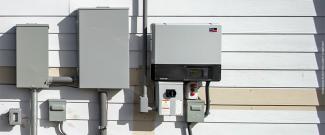Many organizations have established standards that address inverter design, safety, performance, mounting, testing, and maintenance.
Standards are norms or requirements that establish a basis for the common understanding and judgment of materials, products, and processes. They are an invaluable tool in industry and business because they streamline business practices and provide a level playing field for businesses to develop products and services. They are also critical to ensuring that products and services are safe for consumers and the environment.
Inverters are the heart of an off-grid energy system, tying together battery banks, loads, the grid, and backup generators. An improperly operating inverter can damage the energy system, health-care facility appliances, and equipment operators. As a result, standards that dictate inverter safety are critically important. Grid-tied inverters have even more stringent standards to meet the safety and performance regulations created by local utility companies. Following are links to publications from three of the world’s leading publishers of standards and safety information for electrical and related technologies.
International Electrotechnical Commission (IEC)
Inverters
- IEC 62109-1:2010: Safety of Power Converters for Use in Photovoltaic Power Systems - Part 1: General requirements
- IEC 62109-2:2011: Safety of Power Converters for Use in Photovoltaic Power Systems - Part 2: Particular requirements for inverters
Underwriters Laboratory (UL)
Inverters
- UL 1741: Standard for Inverters, Converters, Controllers, and Interconnection System Equipment for Use with Distributed Energy Resources
Institute of Electrical and Electronics Engineers (IEEE)
Grid-Tied Inverters
- IEEE 1547: Standard for Interconnecting Distributed Resources with Electric Power Systems

Hawaiian Electric Light Company
